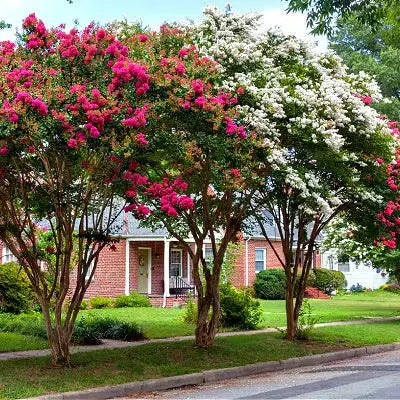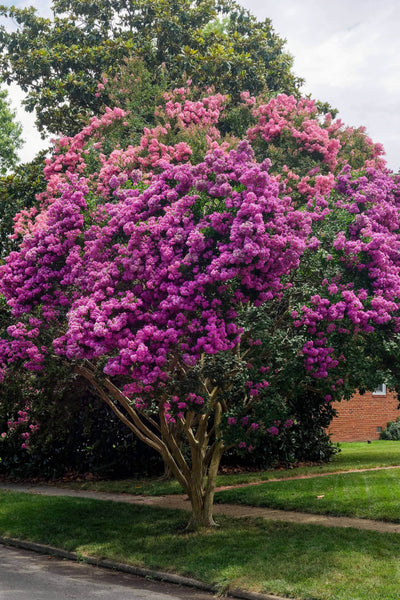Crepe Myrtle and Reasons to Plant Them in Your Garden Garden
Red Crepe Myrtles or Lagerstroemia Indica as some call it, is inches close to being my favorite. You can see why, with its very beautiful, crepe paper like dull pink and purple crepe myrtle flowers. Not to mention, the paper has a smooth bark. It makes it easy to grow trees or shrubs, and wonderful points of interest for the garden with its July to September blossoms.
Sun and well drained soil is a must. Based on the type, it can reach a height of anywhere from 6 to 30 feet! These trees boast lively flowers with a beautiful pale pink, white, bright red, and fuchsia. Their beautiful showy flowers are highlighted by the lovely smooth, peeling bark that graces your garden.
Why Crepe Myrtles Are a Must-Have in Your Garden
If you take a moment to think about it, a crepe myrtle wouldn’t be a bad addition to your garden, and here a few tips why it’s a great choice:
Beautiful Flowers That Brighten Any Landscape
Many curious features about a crepe myrtle plant could be its flowers. Their flowers exhibit very striking colors with brighter reds all the way to gentle whites, giving a garden a tremendous uplift.? It is interesting to note how the red flowers in some soils turn to a pink such as miami pink crepe myrtle, and even a fuchsia, for the crepe myrtle. It adds a whole lot more beauty and dimension to a garden.
If you want full-bodied colors or dense colonies, crepe myrtles forested plantings offer endless design choices. Their flowers in bloom, even alone, offer design aesthetics that can be colorized, and complete with strategic plantings around driveways, pool surrounds, and the perimeters of gardens for a designed finishing touch.
Reduction of Bills with Added Energy Efficiency
Another even almost surprising advantage of the crepe myrtle is the money that could be saved in the energy bills. The branches and flowers of the crepe can supply a lot of shade to the nearby buildings and that lowers the heat the buildings tend to trap, therefore lowering the cooling expenses to those buildings. This is, of course, a very good energy-utilizing idea for both houses and for commercial properties as well.
Surprising Health Benefits
Crepe myrtle trees are not only beautiful additions to gardens, but they also help to improve people’s health. The trees help in inhibiting certain types of cancer, aids in bone repair, and slows down aging. It does this through its chemical compounds.
In folk medicine, flowers are used for minor cuts and burns as a paste. Boiling flowers and using the oil remedies the common cold. The plants also aid digestion, treat obesity, and regulate blood cholesterol levels.
Birdlife Support
Crepe myrtle is not only a delight to gardeners but also a delight to birds. During the summer, the seeds of the crepe myrtle tree attract a number of birds. Cardianals, Finches, Sparrows and even Juncos and they all love the seeds and a bird watcher would enjoy these trees immensely. These types of trees increase the Crepe Myrtle population in the area and help to increase the diversity of the region.
Integrating Crepe Myrtles in the Garden
Creating a Dedicated Crepe Myrtle Space
Building a crepe myrtle garden can completely change the look of a yard with ease. A creative element of this plant is the ability to grow it in either bush/tree form. Planting multiple crepe myrtles is best suited with space in between to avoid overcrowding. Pick dwarf myrtles for small yards and the taller ones for borders and as street trees. With pruning and a bit of maintenance it can easily shift into a tree and bush form.
Combining different plants again the Crepe Myrtles is easy as it has different colorful flowers and perennial garden beds with different flower colors. Another way to class it up is to plant it with ornamental grasses with a layered look.
Guidelines for Proper Care of Crepe Myrtle Trees
Certified as having low-maintenance requirements, Crepe Myrtle plants are ideal for both new and experienced gardeners, having proven drought tolerant once established. Water during times of drought and keep the tree pruned of dead branches. Suction, aphids, and scale are the most common pests, naturally controlled by ladybugs or horticultural oils if needed.
Add Splash of Color to Your within Your Garden with Crepe Myrtle Trees
If you want to add beauty, color, and function to your garden, planting crescent myrtle is the best option. With its beautiful foliage, it can serve multiple purposes within your garden. Whether you are looking for a beautiful centerpiece, a shade-giving tree, or an eco-friendly addition to your garden, a crepe myrtle tree will serve all purposes. For a thriving crepe myrtle plant, visit TN Nursery.
FAQs
Are crepe myrtles good to plant?
Definitely, Crepe Myrtles are a beautiful addition to any garden, blooming throughout summer, hardy to drought, and resilient to grazing by deer, as well as tolerant to pollution. Plus, they are a low maintenance, easy-to-grow crop that encourages nesting by bees, butterflies and other beneficial insects during their flowering season.
What is the difference between a Crepe Myrtle bush and a Crepe Myrtle tree?
The difference is in the pruning and the training you do. A well-maintained Crepe Myrtle that is kept as a bush, will take on a bushy shape, and, if pruned and shaped correctly, will grow into a tree structure. It is a matter of preference as both styles are visually appealing.
Can Crepe Myrtle survive winter?
Crepe myrtle hardy are usda zones 6-9. They are able to withstand some cold temperatures but the winter harsher any area colder than these will not survive without some form of protection. In these locations, It may be wise to bundle the bottom of the plant with burlap or mulch to provide additional blanket for the roots.
Can Crepe Myrtle be kept as a bush?
Yes, Crepe myrtle shrub is characterized by relatively small stems. It can be seen from its small stature that it requires minimal assistance to maintain a dense bodied state.
What is the downside of crape myrtles?
Despite the relatively easy maintenance, crepe myrtle plants can face infestations from scale or aphids. They are also equipped with a lack of control to be actively pruned to stop the “leggy” phase. Another concern would be the loss of balance. Drones myrmecophytes, more than other trees, can be invasive and if not monitored will become a dominant plant.
Where should you not plant a crape myrtle?
Do not plant crepe myrtle in locations with stagnant or poorly drained soil. Like other trees, they also require adequate sunlight. Exposure to the plant should be limited to 50 percent light of the full sun of other plants. Excess water and lack of sunlight will guarantee the plant to thrive poorly accompanied with few flowers.






